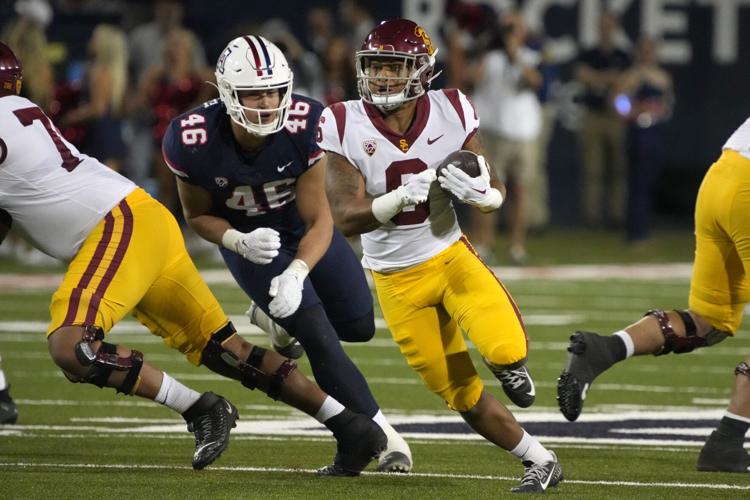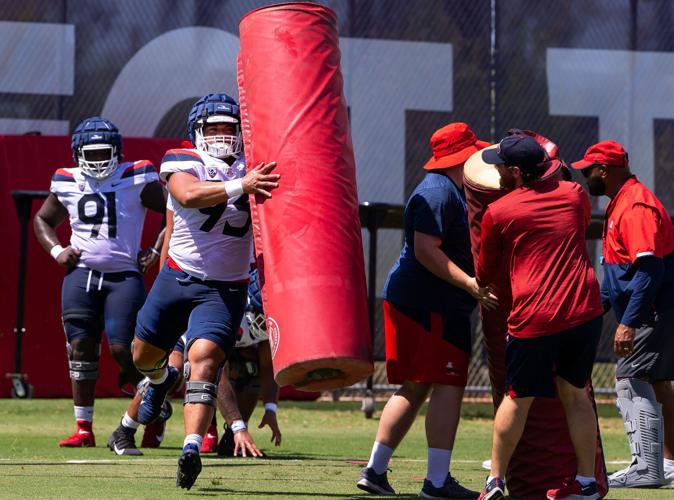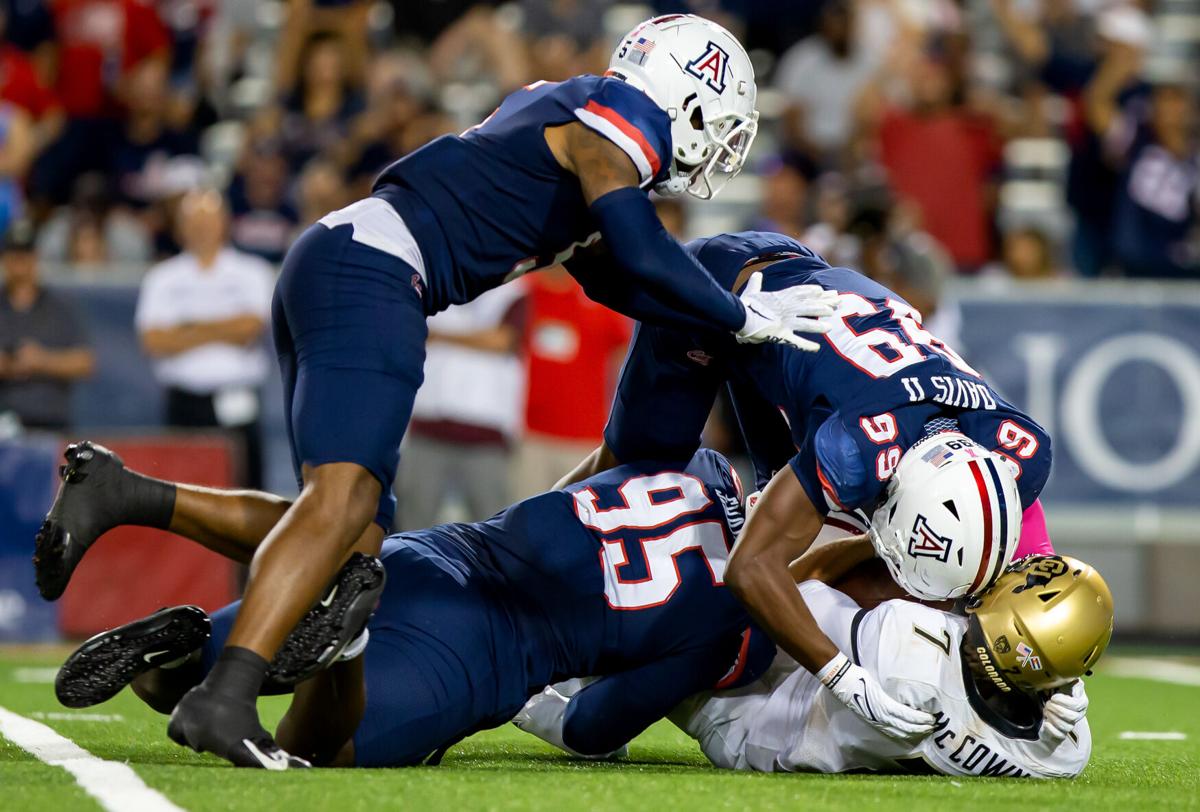SALT LAKE CITY — As they enter the final month of the season, the Arizona Wildcats appear to be operating on parallel tracks.
They are trying to win as many games as they can this year, starting with Saturday’s contest at No. 14 Utah.
They are also planning for future years by integrating true freshmen into the lineup.
As far as Jedd Fisch is concerned, those two objectives are one and the same.
“Really, what it comes down to is, we’re playing the best players — guys that are practicing the best, guys that are playing the best at that moment in time, guys that are giving us the best opportunity to win the game,” the second-year head coach said. “In addition, it’s enabling us to continue to watch the build and be able to see how good people can get.”
He added, just for clarification: “It’s all about winning this game against Utah. We’re gonna play the best 22 players that we believe we have on this roster.”
Arizona started six true freshmen against USC last week, three on each side of the ball. The Wildcats used three additional freshmen in their defensive rotation. Those nine players represent almost 40% of the 2022 signing class, which Arizona hopes will provide the foundation for success in the near future.
The early returns have been favorable.
Receiver Tetairoa McMillan is among the leading candidates for Pac-12 Offensive Freshman of the Year. Right guard Jonah Savaiinaea has started since spring. Tailback Jonah Coleman is averaging 4.6 yards per carry and has three touchdowns.
But it’s on defense where the changes have been the most dramatic of late. It’s also on defense where the Wildcats need the most help.
Defensive coordinator Johnny Nansen, who was hesitant to play freshmen early in the season, has fully embraced Arizona’s youth movement.
“I’m not afraid to play the young guys over the older kids,” Nansen said. “It’s the best guy and how he’s prepared throughout the week.”

Arizona defensive lineman Ta’ita’i Uiagalelei chases USC running back Austin Jones during last week’s game.
Snap judgments
Jacob Manu came first. He started in Week 3 in a three-linebacker set against North Dakota State. Less than a month later, Nansen promoted Manu to the first team.
Defensive lineman Ta’ita’i Uiagalelei and cornerback Ephesians Prysock joined him in the starting lineup against the Trojans. Uiagalelei played a career-high 36 snaps, according to Pro Football Focus, though he’d been trending in that direction. Uiagalelei played between 14 and 19 snaps in the previous three games. Before that, he had played only one.
Prysock saw a massive jump in playing time. He played 73 defensive snaps. Before last week, he had played only five.
Defensive end Russell Davis II continued to play a prominent role in the rotation, logging 21 snaps. It was his fourth game in a row with 12 or more and his third-highest total of the season.
Defensive tackle Jacob Kongaika played a career-high 18 snaps. He played 14 vs. Oregon and eight vs. Washington. He had just six in the first five games combined.
Nansen and the defensive staff found a spot for cornerback Tacario Davis in a 3-1-7 “dollar” package. He played a career-high 12 defense snaps. He had played only two, in the opener vs. San Diego State, before last week.
With Manu playing a career-high 80 snaps — out of a possible 81 — true freshmen accounted for 26.9% of the defensive snaps vs. USC.
“The only way you’re gonna get better is by playing,” Nansen said. “For those guys to have those quality reps vs. good teams ... is going to help out moving forward.”
The coaches didn’t play as many freshmen early on because they weren’t quite ready. Of the six defenders who played vs. the Trojans, only Prysock enrolled in January.
He and Tacario Davis personify the potential of the group once their bodies fill out and they gain more experience. Both are listed at 6-foot-4.
“There’s not too many guys in our league that look like him and ‘E,’ ” Nansen said. “It’s exactly what you’re looking for in a corner.”
All six defensive freshmen are expected to continue to play substantial roles. More first-year players, on both sides of the ball, could get a shot over the final four games. Freshmen can appear in up to four games without losing their redshirt year.

Arizona defensive lineman Jacob Kongaika runs through a tackling drill during the Wildcats’ Aug. 7 practice on campus. Kongaika is one of a handful of young players who could see an expanded role as the season pushes on.
Young men vs. grown men
Playing a bunch of freshmen who’ve had relatively little time in the strength program doesn’t seem like an optimal plan vs. Utah. The Utes typically are among the most physical teams in the Pac-12, and this year is no exception.
Utah appears to be in the midst of its own youth movement, but the Utes aren’t quite as green as their depth chart suggests.
Utah lists 49 players on offense and defense. Thirty-one are listed as freshmen or sophomores.
However, 19 of those players are in at least their third year in the program. The pandemic year, 2020, didn’t count toward anyone’s eligibility.
Six players listed as sophomores have been at Utah since 2019.
So, in many instances, Arizona will be matching young men against Utah’s grown men. Fisch doesn’t mind. He views it as a test and a valuable learning experience for his freshmen and other underclassmen.
“It’s another great opportunity to figure out exactly where we are on the spectrum of the build of this program,” Fisch said. “This is one more step for our guys to find a way to see how good we can become.”
Utah is Arizona’s third opponent out of the past four that’s ranked in the top 15. Barring an upset loss at Arizona State, UCLA will make it four out of five next week.
The margins of defeat have been shrinking — 27 points against Oregon, 10 against Washington, eight against USC. As Fisch again noted this week, Arizona has entered the “losing small” stage of its rebuild. The next stage is winning those close games.
With so many freshmen in the lineup, it might not happen this season. But the experiences they’re gaining now could expedite the process next season — especially if the Wildcats are able to add another strong class of freshmen and transfers.
“We started three true freshmen vs. the No. (10) team in the country, and I thought those kids handled it pretty well,” Nansen said. “Now they’re confident they can play.”







